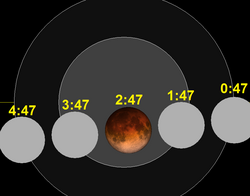| Partial eclipse | |
 From the Solar Dynamics Observatory | |
| Gamma | −1.1004 |
|---|---|
| Magnitude | 0.7875 |
| Maximum eclipse | |
| Coordinates | 72°06′S2°18′W / 72.1°S 2.3°W |
| Times (UTC) | |
| Greatest eclipse | 6:55:19 |
| References | |
| Saros | 125 (54 of 73) |
| Catalog # (SE5000) | 9542 |
A partial solar eclipse occurred at the Moon's ascending node of orbit on Sunday, September 13, 2015, [1] [2] [3] [4] with a magnitude of 0.7875. A solar eclipse occurs when the Moon passes between Earth and the Sun, thereby totally or partly obscuring the image of the Sun for a viewer on Earth. A partial solar eclipse occurs in the polar regions of the Earth when the center of the Moon's shadow misses the Earth.
Contents
- Images
- Eclipse timing
- Places experiencing partial eclipse
- Eclipse details
- Eclipse season
- Related eclipses
- Eclipses in 2015
- Metonic
- Tzolkinex
- Half-Saros
- Tritos
- Solar Saros 125
- Inex
- Triad
- Solar eclipses of 2015–2018
- Saros 125
- Metonic series
- Tritos series
- Inex series
- References
- External links
A partial eclipse was visible for parts of Southern Africa and East Antarctica.











































































































